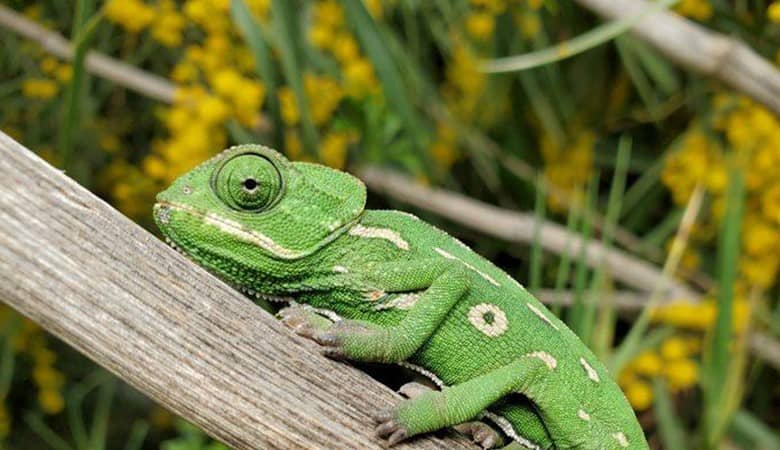Have you ever wished that you could blend in with the background? That’s like having extraordinary powers, seeming invisible and able to hide from predators. Chameleons do this every day, and most people think of it as a really cool trick. And this is basically why lots of people get attracted to the idea of keeping a chameleon as a pet.
But years of research have confirmed that their color-changing ability is more complex than it seems. Their ability to change their colors can mean many things, and blending with their surroundings is not the main reason they do that. Unlike other pets that bark or hiss, when stressed, chameleons change colors. But what’s really going on when that happens? Let’s find out…

How Does a Chameleon Change Its Color?
Several animals have unique pigmented cells that can reflect light to express some colors. But the main difference between most reptiles and chameleons is that the cells of chameleons can easily absorb and reflect certain colors.
Chameleon pigment cells, referred to as iridophores, can act as mirrors. This allows them to reflect a wide range of colors.
These pigments are held in some tiny sacs inside its body. When the chameleon responds to external stimuli, the iridophores either move further away or close to each other, giving the chameleon the ability to show the colors of the light.
When the iridophores move further apart, they reflect colors with longer wavelengths like orange and red. When they move closer, the cells express darker colors with short wavelengths like purple and blue.
So how do we see the color change when the cells are inside the chameleon’s body? The top layer of their skin is transparent. Thus, we can see the many colors underneath as it tries to blend with the plants in their enclosure. If you want to have some fun, you can try this reptile’s ability using a backdrop of different plants for chameleons. Just make sure you pick the right plants that are not only safe for your pet but can also improve the environment in the enclosure.
Why Does a Chameleon Change Its Color?
We all have seen numerous videos of the chameleons matching the colors with their background for the purpose of blending with their surroundings. But you shouldn’t expect your pet to perfectly match the floral background to hide. After all, chameleons can’t transform their skin into some of the crazy patterns in your home. It can express some colors as it tries to blend with its surroundings, but it won’t express bright purple, red or blue color patterns.
When they change their colors, it’s usually brown or green as it blends with the tree it’s sitting on or climbing. Changing their colors is a defense mechanism, and it does that to protect itself from predators. Though they use their colors to hide from predators, chameleons do change their colors for other reasons, too. Here are some of the key reasons they change their colors:
To Express the Mood
When relaxed, chameleons display their natural colors, which can be either brown or green. When they are not feeling aggressive, they’re just trying to relax and avoid being seen. Therefore, they won’t display brighter colors. But if they change their colors from their natural colors to brighter ones like yellow, red, or blue, they feel aggressive. The quick color changes are quite common among male chameleons as they try to defend their territory from anything they consider a threat, including other male chameleons.
If it dims its colors when it meets another male, it means that it is weaker, showing that it doesn’t want to fight and has accepted defeat. Your pet may also change its color to red when angry or excited.
Dark colors are usually an indication that your pet is stressed or unwell. On the other hand, if your pet is green but changes its color to brown, then it is feeling sad.
In the wild, brown color is usually a sign of brumation, which is actually hibernation for cold-blooded creatures like lizards. But in captivity, pet chameleons don’t undergo hibernation since they’re living in a place with regulated environments. Therefore, as a pet owner, you can learn more about your chameleon’s moods. Plus, in most cases, it will return to its original color after the threat has passed.
If it remains in a different color for a very long time—dark colors, in most cases—then there could be something wrong. You may need to take it to the vet, but make sure you do first aid if it’s injured.
A Mating Ritual
Your chameleon can change its color to brighter colors during the mating season. The color they pick varies with species. Most of the time, it’s usually yellow, blue, or red. In an attempt to attract the females, the males will change the color of certain parts of their bodies to stand out.
The females can also change their colors if they’re already mated or are not interested in mating. They can develop dark stripes across their bodies to tell other chameleons that they have already mated. After all, male chameleons are known for being violent. Therefore, the females have to become aggressive if they have already mated with another male. But if she is available, she won’t display too much color and just remain greenish-brown.
Show of Strength
Generally, chameleons can change their colors to two opposing states. They can either try and be seen by changing their color to a more explosive option or be invisible by changing to subtle colors. Chameleons are territorial creatures, and nothing stands out more than dominance against a greenish forest backdrop. So when two males meet, you should be ready for a fierce color showdown.
They will become white, red, or even yellow as they become more visible. The weaker opponent may appear smaller and dimly colored, which means that it’s not ready for a fight. In fact, some males tend to impersonate the females by changing their colors and sneaking into a territory without being detected.
Other Reasons Why They Change Their Colors
The latest scientific theory says that they can change their color to regulate their body temperature. They can change their colors to a darker one when it’s cold as it tries to absorb more heat and change back when their body has warmed up.
Do All Chameleons Change Their Colors?
Yes, all the different chameleon species can change their color. But the main difference between the chameleons is the color they can change to and how fast they can blend in with their surroundings. But not every chameleon species are kept as a pet. The most common pet species is the veiled chameleon.
Veiled chameleons are usually light green in color, but they won’t start changing their color until they reach a certain age. Plus, when they start changing their colors, they can do it within less than 20 seconds. Their most common color pattern is yellow stripes, and they do this when they’re aggressive, see their reflection in the mirror, or don’t want to be handled by their owners. It’s also not uncommon for veiled chameleons to turn brown, but they can return back to green if they’re healthy.
Other chameleon species that aren’t kept as pets can display different natural colors depending on their environment. Some species like the panther chameleons are the most colorful creatures out there. The panther chameleon can be red, teal, green, or a combination of colors, depending on where it lives. Just like the veiled chameleon, the panther chameleon can change its color in less than 20 seconds.
What Color Do They Turn to When They Die?
Chameleons have an average lifespan of about three years in the wild, but when kept as pets, they can live for a maximum of 10 years. These reptiles change their colors throughout their lives, but do they change color when they pass away? Generally, chameleons reflect their true colors when alive, which in most cases is bluish-green. But when they die, most species turn their colors to either dark brown or black.
Even the ones with vibrant colors turn brown or black when they die. The main reason why this happens is that they lose control over their iridophore cells. After all, they’re dead and can’t get excited. The change in color when they die happens to both males and females. In rare cases, chameleons may display lighter colors when dead.
Final Thoughts
Chameleons are exceptional creatures that can light up the mood in the room. In fact, they can be a topic of conversation in your home. Most people still believe that they only change their color when they want to blend with their surroundings. But the truth is that changing their colors is both a defense mechanism and a way for them to express their feelings. A great example is when they change their color as they become aggressive or when they try to walk away from a confrontation.

